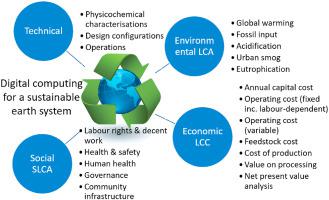Journal of Cleaner Production ( IF 11.1 ) Pub Date : 2021-05-11 , DOI: 10.1016/j.jclepro.2021.127457 Jhuma Sadhukhan , Sohum Sen , Siddharth Gadkari

|
This paper discusses a novel digital output using mathematical computation of life cycle sustainability assessment for design decisions on systemic holistic sustainability of technical systems. The computational social life cycle assessment (SLCA) combining the supply chain import data and social hotspot database for interacting countries in entire supply chain indicates that self-generation in electricity sector gives savings in community infrastructure (68%), governance (53%), human rights (50%), labour rights & decent work (24%), and health & safety (8%), SLCA categories compared to electricity import scenarios in the UK. The life cycle assessment shows the carbon-efficient energy systems for net zero greenhouse gas emissions (GHG) in increasing order of environmental impacts: hydroelectric, wind, biomass, geothermal and solar (4-76 gCO2eq./kWh). The technical and life cycle costing models show that within bioenergy, biomass combined heat and power systems give greater feasibility than microbial fuel cells with a levelized cost of electricity of 0.026 and 0.07 Euro/kWh. TESARREC™ (Trademark: UK00003321198), a novel web-based open-source digital output integrates intrinsic physicochemical, design, operating and systemic characteristics to model and analyse technical systems for sustainability and benchmark/standardise GHG of renewable, biomass and carbon dioxide capture and sequestration strategies for policy directives.
中文翻译:

生命周期可持续性评估数学
本文讨论了一种使用生命周期可持续性评估的数学计算得出的新颖数字输出,用于技术系统的系统整体可持续性的设计决策。计算社会生命周期评估(SLCA)将供应链进口数据和社会热点数据库结合在一起,用于整个供应链中相互影响的国家,表明电力部门的自发电可节省社区基础设施(68%),治理(53%),与英国的电力进口情景相比,人权(50%),劳工权利和体面劳动(24%)以及健康与安全(8%)是SLCA类别。生命周期评估显示,碳排放净额为零的温室气体(GHG)的碳效率能源系统对环境的影响的顺序从高到低依次为:水电,风能,生物质能,地热能和太阳能(4-76 gCO2当量/千瓦时)。技术和生命周期成本模型显示,在生物能源中,生物质热电联产系统比微生物燃料电池具有更大的可行性,其平均电费成本为0.026和0.07欧元/千瓦时。TESARREC™(商标:UK00003321198)是一种基于网络的新型开源数字输出,集成了内在的物理化学,设计,操作和系统特性,以建模和分析技术系统,以实现可持续性以及可再生,生物质和二氧化碳捕集和封存的基准/标准化温室气体。政策指令的隔离策略。

























 京公网安备 11010802027423号
京公网安备 11010802027423号